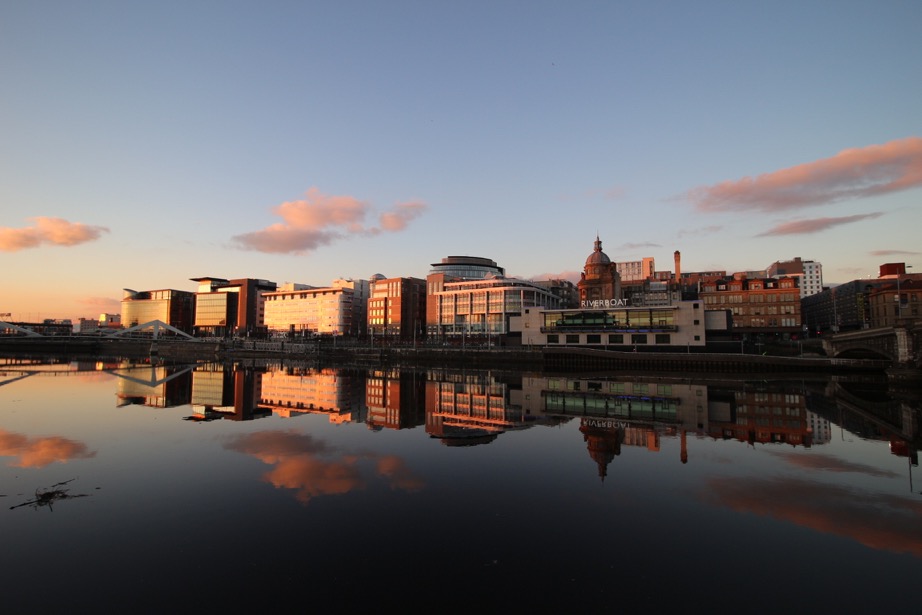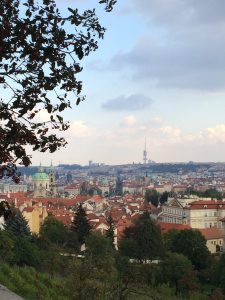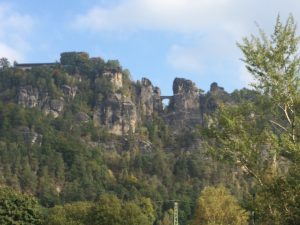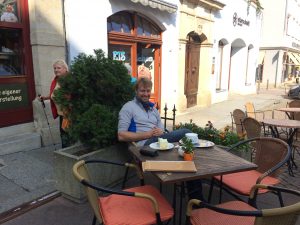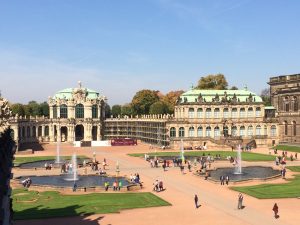Finally, after a far-too-long 18 months, a European train trip; this time to link with a bike tour from Prague to Dresden. Given that both are cities I’ve long wanted to visit, could I arrange a rail odyssey to also include Berlin (another on my tick list), as well as a (fleeting) stop in one of my perennial favourites, Amsterdam?

The bike tour was booked last minute and the trip was the final one for the 2017 season so, essentially, the itinerary, including all travel links and accommodation had to be researched and booked over one weekend. In the event the tight deadline proved to be an advantage: definite decisions had to be made, quickly, with no time for my usual indecisive faffing about.
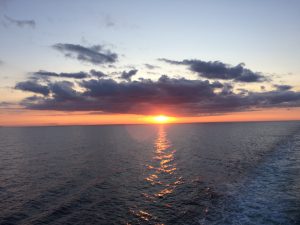
Train-wise, seat61.com as ever, guided me through everything and links to the excellent English language sections of Deutsche Bahn bahn.de (DB) and Czech Railways cd.cz (CZ) worked quickly and effectively. Lack of time did force me to resort to the internet for accommodation though, with one exception, the suggestions did prove to be comfortable and convenient; less so their irritating and unnecessary follow-up adverts.
I source tickets direct from the relevant rail operators. However, it is perfectly possible, and probably more convenient in some cases, to buy European tickets in one package from UK site Loco2 and the same discounts should still be available.
Newcastle-Amsterdam ferry:
This is the second time I have used this method to reach the continent and there are several positives: it saves a journey to London (particularly if the fare is cheaper than the Caledonian Sleeper); living in central Scotland it is easy and pleasurable to travel to Newcastle along the scenic east coast from Edinburgh; the cabins are en suite and, given favourable weather, it’s a very relaxing way to begin/end your journey. And they sell the delicious milk/dark chocolate Dutch Droste pastilles.

However, there are several disadvantages; most notably ‘stealth’ costs. Remember, as a foot passenger you are unlikely to want to carry in food for the evening and next morning, so you have little option but to use the ship’s cafes and restaurants. These are expensive – eg, €21 for fish and chips plus a bottle of beer in the cafe – and not good value.
Pre-booking for the restaurant gains a 17% discount, but still costs £26 for buffet dinner and £11.50 for breakfast – a total of £75 per adult for food alone on a return journey. The cabins, while comfortable, are small and not well suited to sitting around in for several hours in the evening and public areas are restricted to bars and the cinema – again, at cost.

Bus transfers (another extra) do drop off at the main railway stations, (but check carefully the Amsterdam location, under ‘Ports’, as this changed suddenly this summer, with no clear notice from DFDS), and there are several decent breakfast options nearby in both cities, so if you can survive until around 11am, it’s best to delay eating until arrival.
Verdict: can be useful but, on balance, I prefer the Eurostar option, with some time in London. Do work out costs in detail, including hidden extras, as price will probably be the deciding factor.
Amsterdam – Berlin return:
By the time the ferry docks and the bus drops off in the city, it’s almost 11am, so relieved I booked seats on the 13.00 service. Time to have breakfast/coffee/a glimpse of Amsterdam – there are plenty of options in and around the station as well as a large left luggage area.
It’s a six hour journey in a comfortable airline-style seat in a second class open compartment and a pleasant ride across the North German Plain – think final days of WW2 and all that. Indeed, the white steel road bridge you can see at Deventer was used as the famous bridge at Arnhem in the film ‘A Bridge Too Far’. Hanover and Wolfsburg also look interesting for future visits.
Berlin:
Arriving at the spectacular glass and steel Hauptbahnhof (Hbf), I am well impressed to find it is powered by solar energy. From the exit I can see the Reichstag and work out the Brandenburg Gate is only about 20 minutes walk, as is most of the city centre.

The Meininger Hotel is ideally situated just outside the main entrance to the station, on Ella Trebe Strasse, and reasonably priced. Really the next step up from a hostel, the foyer and downstairs area are usually packed with groups of young people. However, the rooms – if not the corridors – are soundproofed, it’s clean, the €6 breakfast is reasonable and the WiFi good. It’s not a luxurious stay, but it’s well located and ideal if you are planning a busy day or two in the city and just want somewhere to put your head down.
It’s raining and as I’m really only on a flying visit, I follow advice from a resident Berliner and buy a day ticket on the city’s transport system for €7. The 100 bus passes many places interest on its way to the zoo, from where I return on the S-Bahn back to the Hbf.


Next day I need to prioritise my sightseeing, so make a beeline for the Reichstag – only 10 minutes walk – and join the queue snaking around the portacabin across the road. I didn’t manage to book online but, fortunately there are a few spaces left this evening at 6pm. (Do remember to take your passport with you, as you will need it, both when you book and to clear security in the Reichstag.)
Norman Foster’s design is simply breathtaking, particularly in the way that light is reflected from different angles. Even on a dank and drizzly evening, the views from the top are superb and the audio guide really informative, both on the Reichstag itself, and on the history of the sites visible across the city panorama. Best of all, it’s free.
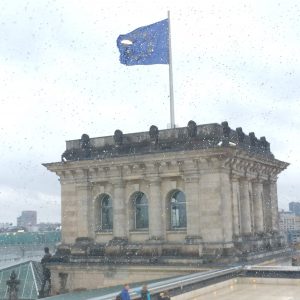
A sore throat and inclement weather dampened my Berlin experience a little, but I still managed to see something of the city and soak up (literally) some of the atmosphere. The tour of the Reichstag Dome was one of the highlights of the entire trip.
I’ll be back.
Berlin-Prague:
Next morning, up early for a four hour journey to Prague, looking forward to seeing some beautiful scenery, particularly between Dresden and Prague. However, although it’s a weekday in late September, the train is absolutely packed, even in first class, with people standing as far as Dresden.
Fortunately, my discounted first class seat comes with a reserved seat, but in a six-seater compartment: just about OK, but with very limited leg room, even for me.
Prague:
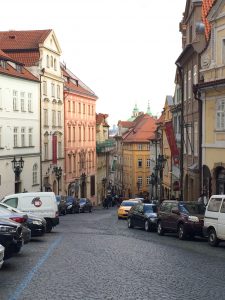
The Royal Plaza Hotel (initially difficult to find because of building works round the museum and opera house) is central and within an easy stroll of both Wenceslas and Old Town Squares. Very pleasant staff, nice room, good WiFi and a bath, all help to provide an enjoyable welcome. So, dump bags, take to the streets where, even on a dullish midweek afternoon, it’s crowded.
First highlight is the Grand Hotel Evropa. Although still closed, its ornate art nouveau exterior stands out even among the crowds and colour of Wenceslas Square; the first of the many art nouveau treasures I want to see in Prague.

Heading down to Old Town Square the crowds thicken and it’s sad to see the reality of Prague’s recent metamorphosis into one of the stag/hen capitals of Europe. When visiting somewhere new I usually assess the extent of commercialisation by the quality of the fridge magnets in the souvenir shops. These are predictable junk. However, by chance I find a lovely Czech-made, all wool, jade beret down one of the side streets: my first and only buy of the day.

Disappointingly, the Astronomical Clock is swathed in scaffolding, but it is still operational and I enjoy trying to identify the four civic anxieties of the 15th century (Vanity, Death, Greed and Pagan Invasion) and then naming (and failing) the 12 Apostles as the clock chimes on the hour.
St Vitus Cathedral has always been at the top of my Prague wish list, but as this is now only possible with the Prague Castle tour ticket, I reluctantly decide against, given my time restrictions – and castles are not really my thing anyway. Charles Bridge, though does not disappoint, despite the drizzle. Once crossed and away from the crowds, there is much of interest along Mala Strana and Petrin Hill. Turning almost immediately right brought me to Shakespeare and Sons, probably Prague’s most famous bookshop. It’s certainly a place for a good read and linger, but conscious of time, I ration my visit and head along Cihelna to the Franz Kafka Museum. A Kafka fan since adolescence, it is an interesting experience and the shop is a cut above the usual museum/heritage offerings (interesting fridge magnets).
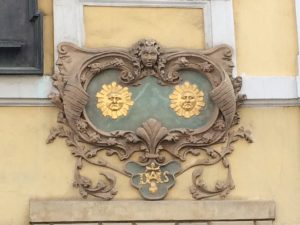
An amusing and quirky detour from here is to walk back to Malostranske Namesti and along Nerudova. Look carefully above the doors and you will see the best collection of house signs in Prague.

House numbering became obligatory in 1770 and these signs show some exotic and eclectic ways of identifying buildings before then. Watch out for the Three Fiddles, the Red Eagle and St Wenceslas on a Horse, among others.
On balance, the highlight of my Prague visit comes on the final day during the Kafka Walk. Living in Glasgow, we are spoiled by our city’s art nouveau treasures, but the Municipal House in Namesti Republiky compares favourably with anything in Mackintosh’s Glasgow, or Horta’s Brussels. Even a glimpse of the foyer and basement takes the breath away with the beauty and symbolism of the designs and decoration. Sign up for a guided tour, you won’t regret it.
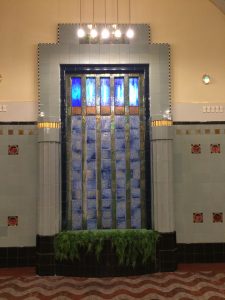
Prague’s crowds are testament to the city’s charisma and attraction. They do clog up the honeyspots and cause irritation, but it’s easy to escape. The city is well served with parks and open spaces – climb Petrin Hill for some of the best views – and the contrasting Vinohrady and Zizkov districts, both easily within walking distance of the main station, are a world away from the tourist traps, with stunning art nouveau architecture, the (in)famous TV Tower, Kafka’s grave in the New Jewish Cemetery and lively bars and nightlife.
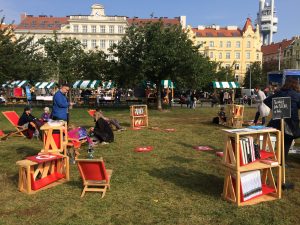
And, there is some decent coffee: TriCafe served up a solid flat white and a delicious strudel. Its comfortable, welcoming atmosphere, nice staff and location near Charles Bridge also tick the right boxes. EMA Expresso Bar produced the best coffee, but its too-cool-for-school atmosphere and know-it-all baristas will not be to everyone’s taste.
Next visit; some more craft outlets are definitely on the menu.
After two long train journeys and some city sightseeing, the wonderful Prague to Dresden cycle tour was just what I needed.
Dresden:
All too often the approaches into a city are not its best advert. Not so Dresden. Cycling into the city along the broad water meadows of the Elbe, past vineyards and Baroque chateaux has to be one of the finest entrances to any city anywhere, and a mouthwatering appetiser to the delights ahead. Arriving by bike after an en route stop at Pirna and the gardens at Pillnitz is even better.

After a convivial last evening with the cycling group, I throw my biking gear into the wash bag and go in search of my next hotel. The Intercity right next to the Hbf could not have been better: ideal location, excellent staff, free city travel card for the duration of the stay, pleasant, well equipped room and the right combination of efficiency and personal, but unobtrusive, service you look for in a good hotel.
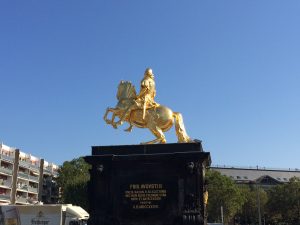
Aiming to make the most of another gorgeous day, I head for Postplatz (in an unsuccessful hunt for good coffee) and cross the Augustusbrucke to Neustadt, giving the crowds in the Inner Alstadt a miss for today. Past the glistening Golden Reiter, I walk up Haupstrasse, a pedestrian boulevard lined with shady plane trees. Here are some of the best-preserved Baroque townhouses in Dresden and the side streets contain some interesting small shops and pavement cafes.
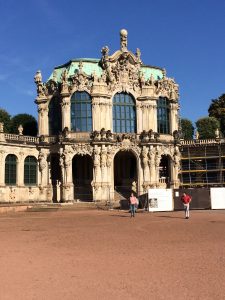
Before I leave Neustadt I walk along to the Pfunds Dairy on Bautzner Strasse. Described in the Guinness Book of Records as the ‘most beautiful dairy in the world’ the shop is over 100 years old and its walls are covered with richly-coloured, hand-painted tiles. It is undoubtedly a striking interior, but unfortunately now very commercialised, selling a range of rather expensive souvenirs: the fridge magnets are, though, a cut above the norm.
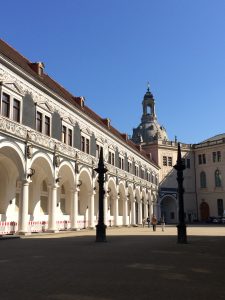
Normally I ration museum visits on a short trip, but there is simply no way I could come to Dresden and not see the Zwinger. The all-in, one day ticket for €10 is good value, although a combination of good weather and too much else to see meant I didn’t manage to get back to the Mathematisch Physikalischer in time.
First up is the Gemaldegalerie Alt Meister. This collection of European painting from the 15th to 18th centuries is simply breathtaking. It is small, but in many ways its size makes it ideal as you don’t feel lost, or frustrated that you cannot see everything, as is often the case in larger ‘national galleries’. Particular favourites include the Chocolate Girl and Canaletto’s impressions of Pirna, especially as we had visited its famous town square en route to Dresden on the cycle tour.

The Porcelain Collection is next and, although I was aware of Dresden’s associations with white Meissen porcelain, I had no idea of the extent of the city’s collection of specialised ceramics – generally regarded as the best in the world. August the Strong’s passion for ceramics resulted in an amazing collection of porcelain and stoneware, particularly from China and Japan. and the displays here certainly set them off to best effect.

A trip on the tram and a quick browse through Inner Alsadt is, I’m afraid, all I have time for. The Frauenkirche, Semperoper opera house, Residenzschloss and the little shops of the Kunsthofpassage, will be first on the list for my next visit.
Postscript:
i) everything travel-wise went like clockwork: message to self; perhaps booking at the last minute clears the mind and is the way to go in future
ii) the train journeys were all on time and generally relaxing, although very crowded at times. My idea of taking two bags of reasonable weight, rather than one heavy case, did ensure I could lift them on overhead racks, but they were difficult to transport when walking any distance
iii) the ferry is the weak link on this type of journey for the reasons above. The new Eurostar direct service to Amsterdam and the Caledonian Sleeper upgrade next year look to be better options and an overnight in London/Brussels/Amsterdam as economic as the ferry, given DFDS’s ‘hidden’ extras.
Ultimate highlight? a dead heat between the cycle tour, Dresden and the Reichstag Dome.
All in all, this was one of the best trips of recent years and an ideal rehearsal, all being well, for 2018’s planned piece de resistance; The Stuff Brexit, Grand Euro Tour.
Watch this space.
